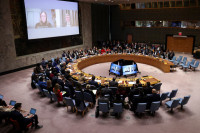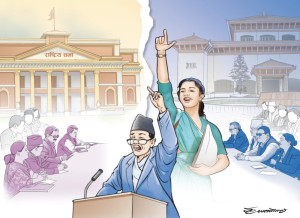Columns
Farming falls on women's shoulders
But their work and contributions tend to be invisible to policymakers and academics.
Subarna Malla Singh
Women farmers in Nepal have become, by default, the country's primary farmers. Out of every five farmers in Nepal, four are women. The absence of productive work in rural areas has impelled young and able-bodied males to out-migrate overseas for contract wage employment. This has resulted in increasing feminisation of agriculture and the rural women left behind have become de facto farmers in de jure male-headed households. They have also become decision-makers rather than being decision-takers. This has resulted in far-reaching consequences on the agricultural landscape of the country.
However, Nepal has yet to recognise women farmers as de jure farmers in their own right. Women have been working side by side with men on agricultural land for centuries. They work harder and longer than men, whether it is in the cultivation of cereals, cash crops and vegetables or poultry farming, livestock raising and management, and forest conservation and management, among others. Their work and contributions tend to be invisible to policymakers and even academics. This is due to the fact that women’s work is not considered as work in national income accounts and in population and agricultural censuses.
Unrecognised and unappreciated
Women working on agricultural land are simply noted as 'helpers'. They not only bear the brunt of the work burden, but are also unpaid, unrecognised and unappreciated. Women working on agricultural land day in and day out is a common sight in Nepal, so much so that they have become part and parcel of the agricultural landscape. Yet they are visibly invisible. This invisibility has deprived women farmers their rightful access to productive agricultural inputs and services. Despite purported gender mainstreaming in agriculture, their needs and constraints have tended to be pushed to the back burner as the general retort is 'they have been mainstreamed'.
Lack of comprehensive understanding of the concept of gender mainstreaming in agriculture has engendered the misconception that there is no need for separate women-targeted agricultural programmes, adding to the woes of women farmers. Female and male farmers have different needs and constraints. Female farmers, unlike male farmers, are burdened by their triple duties as dictated by societal gender norms. Moreover, female farmers are not provided with a level playing field. Agricultural policy still tends to be male-oriented and has not yet fully acknowledged the uneven playing field for female farmers.
Despite reforms in women’s property rights, various sub-clauses relating to property laws have effectively prevented them from inheriting property, including land. Almost all female farmers work on agricultural land owned by males in male-headed households. In a predominantly agricultural developing country, land is a much valued primary asset. The available data reveals that only 9 percent of the land is female-owned and 91 percent of women own neither house nor land. Worse, the size of the land owned by females is much smaller, and the quality is poorer than that of male-owned land.
To encourage female land ownership, there is now a 25 to 50 percent tax exemption on the registration fee for registering land in a female’s name and a 35 percent discount for single women. A nominal fee of Rs100 is charged for joint registration of land in the names of the husband and wife. Unfortunately, there have been reports of misuse of the discount by male members, the mafia and real estate entrepreneurs.
The absence of land ownership has deprived females of not only the socially and legally accepted title of female farmers, but also access to irrigation water and institutional credit, among others. While irrigation law has mandated 33 percent reservation for women in the Water Users Association, it has skirted the issue of their legal right to access irrigation water in the absence of land ownership. Women put in more hours than men in irrigation water management, but they have little or no effective access to irrigation water or management.
Bank credit
Land is the preferred collateral for banks and other formal financial institutions. The absence of land ownership has deprived women of easy access to institutional credit which is much cheaper than loans from informal sources. Women have no choice but to depend on relatives, friends and moneylenders for their credit needs. The tendency of agricultural services and research institutions and technology to be male-oriented, and thereby catering more to male farmers, has had negative impacts on female farmers.
Various field studies have traced changes in land use patterns, mode of cultivation and changes in the kind of crops grown to female farmers’ coping strategy. As they have difficulty in accessing much needed agricultural inputs and services, some have even abandoned their agricultural land and migrated to urban areas, creating an adverse effect on agricultural production and growth, and imports of food and agricultural products, among others. The sooner the country wakes up to this reality, the better positioned the country will be to achieve sustainable agricultural growth.
***
What do you think?
Dear reader, we’d like to hear from you. We regularly publish letters to the editor on contemporary issues or direct responses to something the Post has recently published. Please send your letters to [email protected] with "Letter to the Editor" in the subject line. Please include your name, location, and a contact address so one of our editors can reach out to you.




 13.25°C Kathmandu
13.25°C Kathmandu















